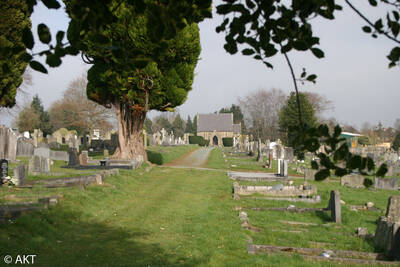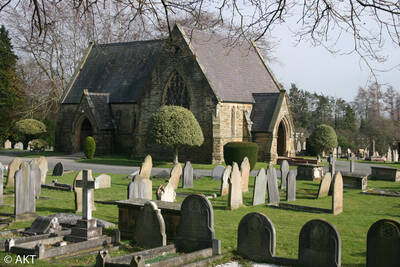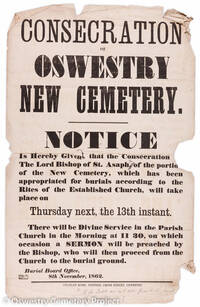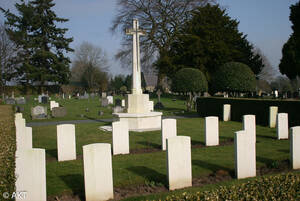A new burial ground
On 27 June 1859 at it was decided at a Vestry meeting ‘it was a necessity to provide the town with a new burial ground’. The Shrewsbury Chronicle states that the Vestry meeting was a large meeting and much was said before the decision was made, but it did not outline townspeople’s reason for doing so or why it was a necessity.
Many cemeteries of the era were created as an antidote to the insanitary conditions of overstressed churchyards. Population growth and epidemics such as cholera quickly filled the graveyards, and many of the burials were not adequately performed causing health risks. Like other towns of the period, Oswestry experienced a growth in its population during the first half of the nineteenth century. In 1801 the population of the parish was 5,839, in 1861 it had grown by sixty percent to 9,357. There had been at least two outbreaks of cholera in Shropshire since the 1830s. These may have been contributing factors that informed the decision to provide the town with a new cemetery.
Another reason for the decision may have been that the new cemeteries catered for non-conformist burials. By the time of the Burial Act of 1857, it was not even deemed necessary to demarcate the consecrated sections from the ‘general’ sections by a separating wall. Oswestry in the late 1850s had a significant non-conformist population. Harrod’s Directory of Shropshire 1862 recorded ten places of worship for the town, eight of which were non-conformist which included:
- Baptist Chapel, English Walls
- Calvinistic (Welsh) Methodist Chapel, Castle Fields
- Independent Chapel, Arthur Street
- Independent (Methodist) Chapel, Beatrice Street
- Primitive Methodist Chapel, Castle Fields
- Welsh Calvinist (Zion) Chapel, Welsh Walls
- Wesleyan chapel, Salop Road
- Wesleyan (Welsh) Meeting House, Salop Road
Cemeteries were seen as civic undertakings that enhanced the status of the towns they serviced. Many Victorian cemeteries were used as places to perambulate and be seen. Oswestry Cemetery, situated on the junction of Salop Road and Victoria Road, was adjacent to two other Victorian civic features of advancement, the Gas Works and the Railway. Its appearance from the road did not make it an inviting place to visit to take a Sunday afternoon stroll, but the views once inside the Cemetery are open, giving good views down the valley towards the Breidden Hills.

The issue of status, and particularly class, can be found in the Cemetery. The different sections were laid out with three areas for first, second and third class burials. The first class graves (coloured in red on the early maps) were next to the pathways. They could easily be seen and access would not require walking around graves or over grassed areas. The second class graves (coloured in yellow) consisted of two rows immediately behind the first class graves. The centre part of the sections (coloured blue) contained the third class graves. The third class graves include the multiple burials of paupers and often do not have memorials. There were different fees for the different classes of graves.
The main reason why a new cemetery was a necessity can be found in a short history of the Cemetery in the first Burial Board minute book in a statement presented at the Burial Board’s termination in 1895. A cemetery was needed because in 1856 all burial grounds in Oswestry were closed by an order in Council with exceptions, which restricted the burials. The exceptions were that burials could take place in new unopened graves and existing brick lined graves and vaults. No ordinary grave could be reused. The Burial Acts of the 1850s enabled vestries to raise funds for the provision of new cemeteries as part of the poor rate. The administration was to be run by Burial Boards which consisted of local ratepayers. This ability for vestries to raise funds and the restrictions on burial grounds in the town were the main motivators for the resolution to provide Oswestry with a new cemetery.
Oswestry Burial Board
Oswestry Burial Board was created the week following the Vestry meeting and Richard Jones Croxon was chosen as Clerk. One of the first tasks of the Burial Board was to find a suitable site for the Cemetery. Several sites were tested using the eight foot test for water and many places failed the test. On 7 November 1859 Charles Minshall agreed to sell four acres of his land by the Gas Works on the junction of Salop Road and Victoria Road. The site was approved by the Home Office early the following year.
Building and design
The next task of the Burial Board was to get a design for the Cemetery. In March 1860 an advert was placed in local papers and the ‘Building News’ requesting designs. Initially there was no interest, so the Burial Board made the process into a competition by offering prizes of £15 and £10 for the best two entries. The process was not without its problems and criticism. Once the designs started arriving, the Board suspended them from the walls of the Guildhall, but once they were on display they decided that they were not qualified to judge the entries. Architect, Mr Poutney-Smith of Shrewsbury was employed to choose the best two entries. Mr Beazley, a competitor, complained to the Board regarding their handling of the process.

Eventually Hans Price of Weston-Super-Mare was chosen to be the architect of the Cemetery. He was awarded five percent of the outlay with three guineas per journey. Later in the year William and John Morris of Oswestry were awarded the contract to build the lodge and the chapels. Their quote for the work was £1,276. Edward Evans of Oswestry was awarded the contract for laying out the grounds. He quoted £508.
The first Cemetery Superintendent
Once the work was completed in 1862 John Jones, a former porter at Morda Workhouse, was appointed as the Cemetery Superintendent. He was awarded a salary of £50 and residence at the lodge rent-free. For his salary he was expected to look after the trees, shrubs and flowers, mow the grass, roll the ground, and scuffle and clean the walks. Any manual labour was to come out of his salary.
The first burial - Sarah Fox

On 13 November part of the Cemetery was consecrated and the new burial ground was officially opened. On 26 December 1862, Sarah Fox, aged 73, was the first person to be buried at the Cemetery. Sarah is buried in Section A, Grave 132, in a second class grave along with other members of the Fox family. As part of the Oswestry Cemetery Project, Sarah’s gravestone was restored. Details of the restoration can be found in the website blog. The research volunteers found that Sarah was not born in Oswestry, she was initially from Middlesex. She married Richard Fox, who Isaac Watkin records, was one of the last Oswestry to London carriers.
Extensions
The Cemetery has been extended twice, firstly in 1900 and again in 1946. In 1900, three acres, three roods and eighteen perches of adjoining land was purchased for £800 from the trustees of the will of the late Charles Minshall. In 1946, five acres, three roods and two perches from the representatives of Robert George de la Poer Beresford (deceased) was purchased for £950. The site currently contains in excess of 22,000 burials.
War Graves

Oswestry Cemetery contains a designated Commonwealth War Graves area with its own memorial which can be found in Section T. Commonwealth War Graves can also be found outside the designated area scattered throughout the Cemetery. Many of the graves are easily recognisable by their brilliant white Portland stone headstones, although some of the War Graves are less easily recognisable as they are part of family plots. The War Graves are easily spotted in November as the Cemetery staff mark the graves with a cross and poppy for Remembrance Day.
Oswestry Cemetery is the burial place of Oswestry’s own Victoria Cross veteran, Sergeant Harold Whitfield. He was presented with his medal on 31 May 1918 by King George V at Leeds Infirmary.
The Cemetery was also the place of rest for three World War Two prisoners of war for several years. The remains of Karl Hauck, Karlo Sioli and Hans Steffen were transferred to the Cannock Chase German Military Cemetery in 1963.
Oswestry Cemetery administrative bodies
1859-1894 Oswestry Burial Board
1895-1974 Oswestry Joint Burial Board
1974-2008 Oswestry Joint Burial Committee
2008- Oswestry Town Council
The Cemetery records are held at Oswestry Town Council Archives and have been conserved and catalogued as part of the Oswestry Cemetery Project.

